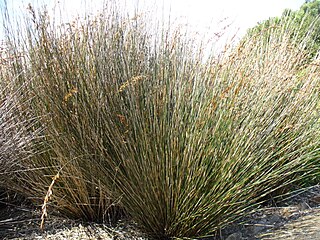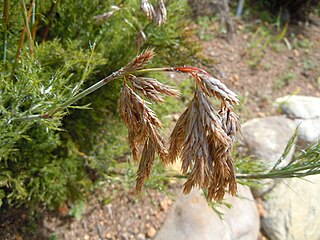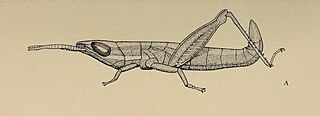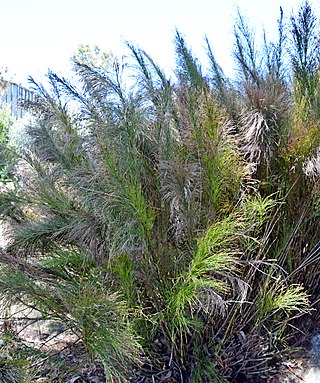
The koala, sometimes called the koala bear, is an arboreal herbivorous marsupial native to Australia. It is the only extant representative of the family Phascolarctidae and its closest living relatives are the wombats. The koala is found in coastal areas of the mainland's eastern and southern regions, inhabiting Queensland, New South Wales, Victoria, and South Australia. It is easily recognisable by its stout, tailless body and large head with round, fluffy ears and large, dark nose. The koala has a body length of 60–85 cm (24–33 in) and weighs 4–15 kg (9–33 lb). Fur colour ranges from silver grey to chocolate brown. Koalas from the northern populations are typically smaller and lighter in colour than their counterparts further south. These populations possibly are separate subspecies, but this is disputed.

Fynbos is a small belt of natural shrubland or heathland vegetation located in the Western Cape and Eastern Cape provinces of South Africa. This area is predominantly coastal and mountainous, with a Mediterranean climate and rainy winters. The fynbos ecoregion is within the Mediterranean forests, woodlands, and scrub biome. In fields related to biogeography, fynbos is known for its exceptional degree of biodiversity and endemism, consisting of about 80% species of the Cape floral kingdom, where nearly 6,000 of them are endemic. This land continues to face severe human-caused threats, but due to the many economic uses of the fynbos, conservation efforts are being made to help restore it.

Reed is a common name for several tall, grass-like plants of wetlands.

The Terek sandpiper is a small migratory Palearctic wader species and is the only member of the genus Xenus. It is named after the Terek River which flows into the west of the Caspian Sea, as it was first observed around this area.

The Restionaceae, also called restiads and restios, are a family of flowering plants native to the Southern Hemisphere; they vary from a few centimeters to 3 meters in height. Following the APG IV (2016): the family now includes the former families Anarthriaceae, Centrolepidaceae and Lyginiaceae, and as such includes 51 genera with 572 known species. Based on evidence from fossil pollen, the Restionaceae likely originated more than 65 million years ago during the Late Cretaceous period, when the southern continents were still part of Gondwana.

The brown snake eagle is a fairly large species of bird of prey in the family Accipitridae. It is found in West, East and southern Africa. This species is an almost obligate predator of a variety of snakes. A very solitary bird, the brown snake eagle has a prolonged breeding cycle and raises a single eaglet. Although probably naturally scarce, it is classified as a least concern species as it continues to occur over a very broad range.

Restio is a genus of flowering plants within the family Restionaceae, described in 1772. The entire genus is endemic to the Cape Provinces and KwaZulu-Natal in South Africa.

Thamnochortus insignis is a species of grass-like restio of the family Restionaceae, endemic to Cape Province in South Africa.
Cassionympha detecta, the Cape brown, is a butterfly of the family Nymphalidae. It is found in South Africa, in the mountains of the Western Cape from Cederberg to Swartberg down to the coast, then along the south-east coast and hills to the Eastern Cape and into Great Karoo.
T. insignis may refer to:

Cape Lowland Freshwater Wetland is a critically endangered vegetation type of the Western Cape, South Africa.

Elegia tectorum, previously Chondropetalum tectorum or Restio tectorum, more commonly Cape thatching reed, or dakriet, is a member of the restio family, Restionaceae. It is a tufted perennial growing to between 1.5 and 2.25 m, with deciduous leaf sheaths. Flowers are less than 3 mm long. Petals are smooth or hairy in the upper half. E. tectorum is found in marshes and seeps on deep sand in the Western Cape and Eastern Cape of South Africa.

Staberoha is a group of plants in the Restionaceae described as a genus in 1841. The entire genus is endemic to Cape Province in South Africa.

Thamnochortus is a group of plants in the Restionaceae described as a genus in 1767. The entire genus is endemic to Cape Province in South Africa.
Betiscoides meridionalis, the slender restio grasshopper, is a species of lentulid grasshopper which is endemic to South Africa. It occurs only in the Western Cape where it is found in damp areas, in upland areas and on plateaux, vegetated with Restio species. This flightless grasshopper is threatened by droughts and wildfires which destroy its habitat. It is classified as an endangered species on the IUCN Red List.

Betiscoides is a small genus of southern African grasshoppers in the family Lentulidae.

Elegia capensis, called the horsetail restio, is a species of grass‑like flowering plant in the genus Elegia, native to the Cape Provinces of South Africa. It has gained the Royal Horticultural Society's Award of Garden Merit.

Restio subverticillatus, the whorled restio, is a species of flowering plant in the family Restionaceae. It is endemic to the southwestern Cape Provinces of South Africa.

Rhodocoma capensis, called the Cape restio, is a species of reed-like perennial grass in the family Restionaceae, native to the southwestern Cape Provinces of South Africa. Growing over 2 m tall, with clumping, jointed stems, it has gained the Royal Horticultural Society's Award of Garden Merit as an ornamental, suitable for borders and architectural applications.
















